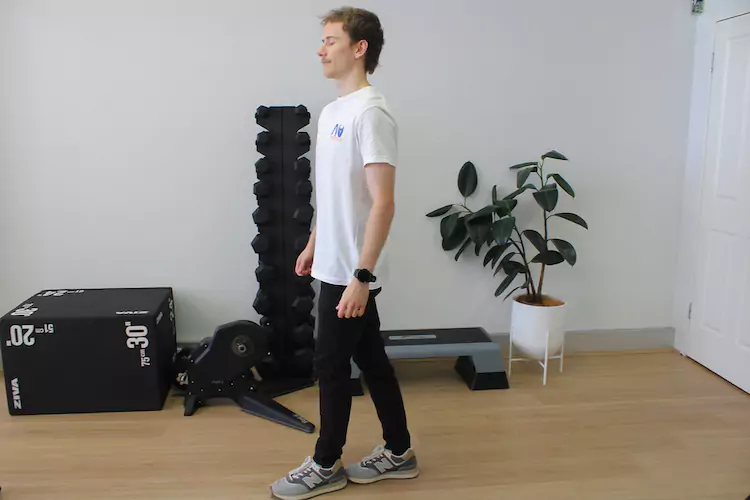I’ve worked with many clients who struggle with balance and dizziness. Fortunately, there are a number of vestibular rehab exercises that can help improve your equilibrium and reduce dizziness.
Here, I’ll cover 8 vestibular rehab exercises that may help improve balance and dizziness. I’ve included exercises you can do right at home, with minimal equipment, as well as modifications to get you started.
In This Blog
- Gaze stabilisation / VOR single leg
- Gaze stabilisation / VOR regular standing
- Vestibular proprioception training with laser
- Walking with head turns
- Saccades
- Balance with ball throwing
- Smooth pursuit
- Modified Romberg stance / Tandem stance balance
Top 8 Exercises for Vestibular Rehabilitation
Note: Before beginning any vestibular exercises, consult with a vestibular physiotherapist or healthcare professional to ensure the exercises are suitable for you.
1. Gaze Stabilisation / VOR Regular Standing
If gaze stabilisation on one leg is too difficult for you, here is a modification to try.
Intended Benefits
- Improve vision
- Promote the ability to focus on stationary objects even while the head is moving
- Promote overall improvements in balance and mobility
- Help recalibrate the brain, inner ear, and eyes after damage to the inner ear
How to Do the Exercise
- Stand on both legs, keeping legs about shoulder-width apart
- Look straight ahead and focus on a letter, your thumb, or an object at eye level in front of you
- Turn your head slowly from side to side while maintaining focus on your target and maintaining your balance
- Continue doing gaze stabilisation until you notice mild to moderate dizziness.
- Work your way up to completing this exercise for longer periods of time (up to one minute) to help your brain adapt
- Build up to repeating this exercise three to five times a day
Note: If you cannot do gaze stabilisation while standing, practice it while sitting first.
2. Gaze Stabilisation / VOR Single Leg
Intended Benefits
- Improve vision
- Promote the ability to focus on stationary objects even while the head is moving
- Promote overall improvements in balance
- Help heal damage to the inner ear
How to Do the Exercise
- Stand on one leg
- Look straight ahead and focus on a letter, your thumb, or an object at eye level in front of you
- Turn your head at a moderate speed from side to side while maintaining focus on your target and maintaining your single leg balance
- Continue doing gaze stabilisation until you induce mild to moderate dizziness
- Work your way up to completing this exercise for longer periods of time (up to one minute) to help your brain adapt
- Build up to repeating this exercise three to five times a day
Note: This exercise lends itself to a wide range of progressions and modifications. If standing on one leg is too hard, I recommend starting with gaze stabilisation while standing on both legs (which I’ll cover later in this article).
To make gaze stabilisation more difficult, try moving your head quicker or up and down instead of side to side.
3. Vestibular Proprioception Training with Laser or Mirror
Intended Benefits
- Improve proprioception and spatial awareness
- Improve cervico-occular reflexes
How to Do the Exercise
- Draw an cross on your mirror with a whiteboard marker
- Stand in front of mirror so that the vertical line runs through the center of your eyes
- Close your eyes, turn your head to the left and return back to where you think the line will intersect the centre of your eyes
- Open your eyes and check
- Repeat 5-10 times each side making adjustments as needed
4. Walking with Head Turns
Intended Benefits
- Improve overall balance
- Help improve vestibular efficiency and endurance
- Reduce sensitivity to dizziness
- Improve mobility
How to Do the Exercise
- While walking, gently and smoothly turn your head side to side
- Try walking in a straight line while continuing to turn your head left to right and right to left
- Try to sync up your steps with the way you turn your head (i.e. step with your right foot, look to the right)
- Try to walk while turning your head side to side for the entire length of the hallway and begin building your way up to 1 minute at a time
- Rest before repeating the process for a total of 3 times
Note: Once you check with a healthcare professional that walking with head turns is a suitable exercise for you, I recommend performing it in a hallway. In a hallway, the nearby walls provide a good stabilisation option if you get slightly off balance.
5. Saccades
Intended Benefits
- Improved head and eye movement control
- Improve vestibular efficiency and endurance
- Build up the brain’s tolerance to dizziness to reduce symptoms of vertigo and dizziness
How to Do the Exercise
- Hold your two index fingers at arms length out in front and roughly 80cm apart
- Without moving your head, move your eyes rapidly to focus on your right index finger
- Once gaze is stable, rapidly shift your gaze to the left index finger without moving your head
- Repeat this process back and forth between the two fingers
- If you are unable to hold your arms in front, you can use markers on the wall in front (playing cards for example)
Note: I recommend performing this exercise while sitting in a chair facing a while or while standing. Start with whatever position is most comfortable for you. I suggest using a timer on your phone to easily track your rounds.
6. Balance with Ball Throwing
Intended Benefits
- Improve hand-eye coordination
- Improve overall balance
How to Do the Exercise
- Throw a small rubber ball from hand to hand at just above eye level
- Next, lift up one leg and throw the ball from hand to hand under one knee
- Repeat on the other leg
- If the standing positions are too difficult, sit in a chair as you throw a small ball from hand to hand at just above eye level
- Try to complete 3 rounds of 30 seconds of throwing
7. Smooth Pursuit
Intended Benefits
- Help promote healing after an inner ear injury
- Help reduce symptoms of dizziness
- Help retrain the brain
How to Do the Exercise
- Hold a single target in front of you
- Keep your eyes fixed on the target
- Slowly move the target side to side while keeping your head still
- Aim to do this for 30 seconds
- If you successfully complete this in the sitting position, try it in the standing position
8. Modified Romberg Stance / Tandem Stance Balance
Intended Benefits
- Improve balance and stability
- Reduce the risk of falls
- Improve proprioception and vestibular efficiency
How to Do the Exercise
- Stand in an open space with your feet heel to toe
- Once stable in this position, close your eyes
- Try to hold this position for as long as possible – ideally longer than 30 seconds
FAQs
What are vestibular exercises?
Vestibular exercises purposely challenge balance and stimulate dizziness. By provoking dizziness in a controlled manner, vestibular rehab exercises may help build up a tolerance to dizziness in your brain. Just as some exercises make your muscles stronger, vestibular physiotherapy exercises are designed to strengthen your brain and balance.
What is vestibular physiotherapy?
Vestibular physiotherapy is specialised physical therapy intended to address balance and dizziness difficulties that are a result of vestibular system issues. The vestibular system includes the parts of the brain and inner ear related to controlling eye movements and balance.
You May Also Like: What to Wear to a Physio Appointment
How do vestibular exercises work?
Vestibular exercises retrain the brain by stimulating the vestibular apparatus. This stimulation purposely induces dizziness and challenges balance. By consistently stimulating dizziness, the brain begins to tolerate it. I’ve seen many patients experience huge breakthroughs in balance and mobility through vestibular rehabilitation exercises personalised to their needs. I enjoy seeing patients report feeling less dizziness and feeling more capable of completing their daily tasks.
What are the benefits of vestibular rehab exercises?
Benefits of vestibular rehabilitation exercises may include:
- Train the eyes to move independently of the head
- Heal inner ear damage
- Retrain the brain
- Improved overall balance
- Improved muscle awareness
- Improving dizziness and vertigo
- Improved quality of life
- Enhanced stability
- Increased confidence in completing daily tasks
- Increased mobility
- Reduced risk of falls
What are some good tips for starting vestibular rehab exercises?
I only recommend performing vestibular rehab exercises under the supervision of a physiotherapist. A licensed physiotherapist will show you how to perform the exercises safely, determine modifications if needed, and ensure you execute the exercises with proper form.
Here are some of the tips I give my patients when beginning vestibular physiotherapy exercises:
- Some level of dizziness is normal but stop the vestibular exercises if dizziness becomes severe
- Have another person present as you perform vestibular physiotherapy exercises
- Work with a trained physiotherapist who can supervise your progress
- Start slow and use modifications as needed
- Stay consistent
- If you still become nauseous, take a break until your next session
Need Help With Your Vestibular Exercises?
Vestibular physiotherapy exercises can be an important part of reducing symptoms of dizziness and improving overall balance.
While some of these exercises for vestibular rehabilitation can be completed at home, they are best performed under the supervision of a physiotherapist.
At Physio and Exercise Lab, our physiotherapists specialise in addressing balance issues, dizziness, and other symptoms of vestibular disorders.
Using advanced assessment techniques, we identify the root cause of your symptoms and determine which vestibular exercises will help you rebuild your quality of life.
Our goal is to use an entirely non-invasive approach and targeted vestibular exercises to improve your overall well-being, reduce symptoms of dizziness, and help you regain confidence in going about your daily tasks.
Contact our team with questions or to book a vestibular physio appointment with one of our talented, caring physiotherapists.


















